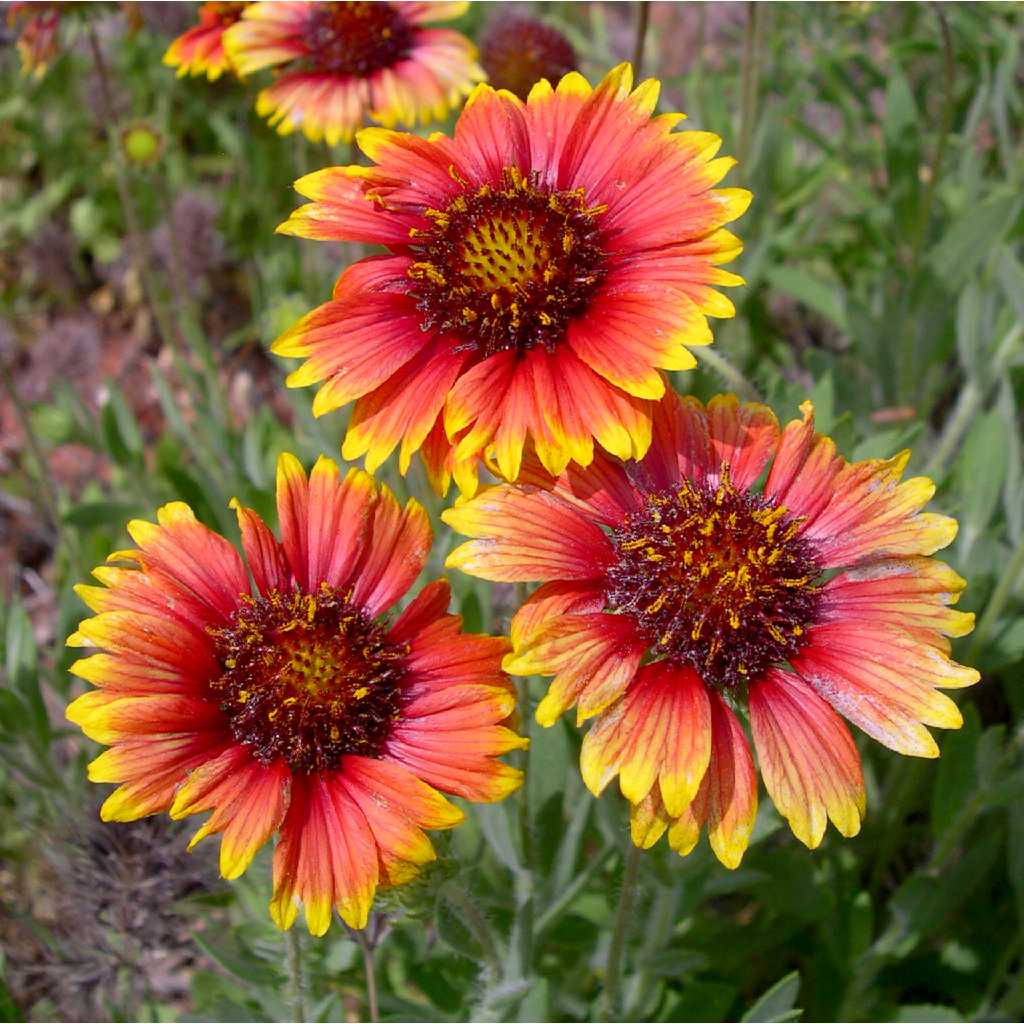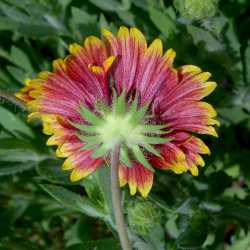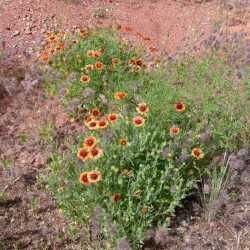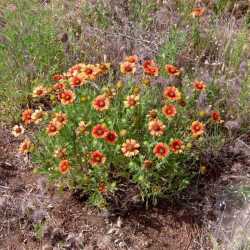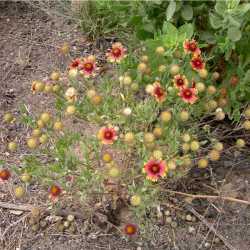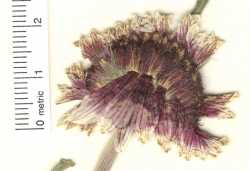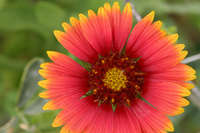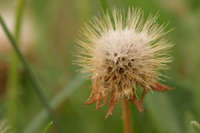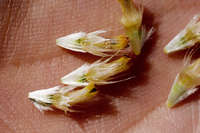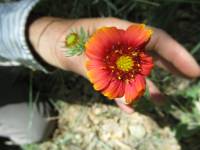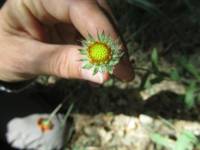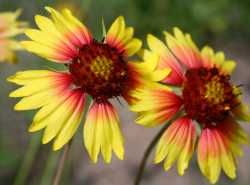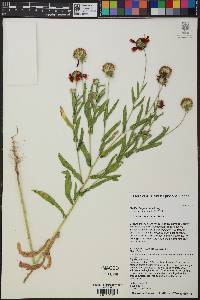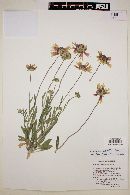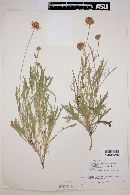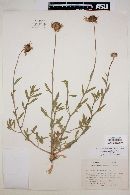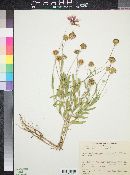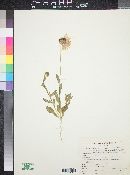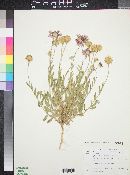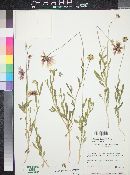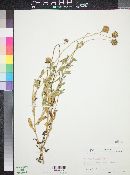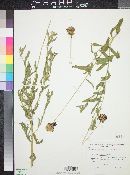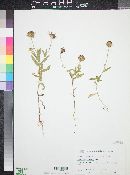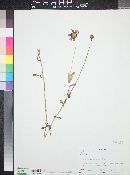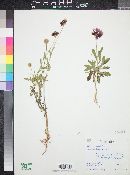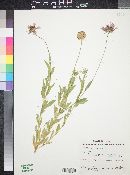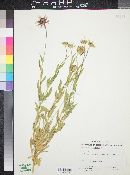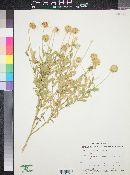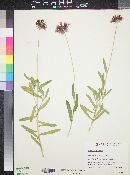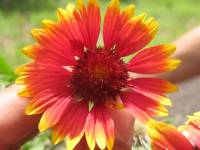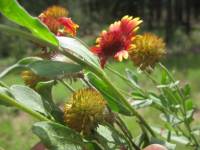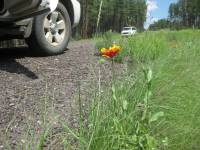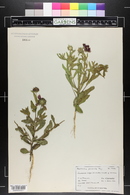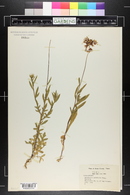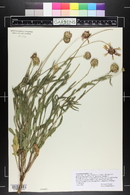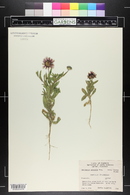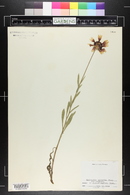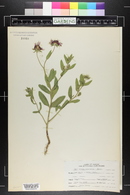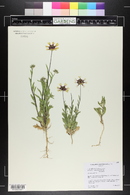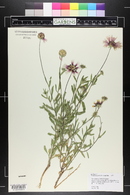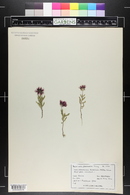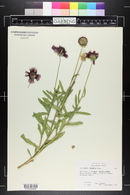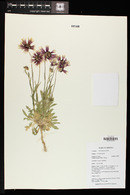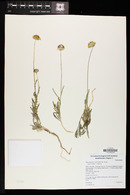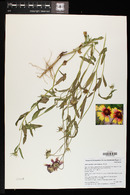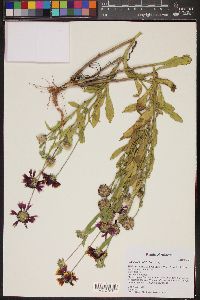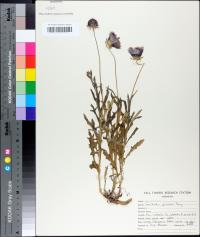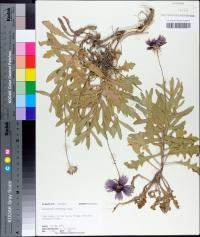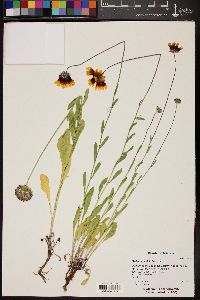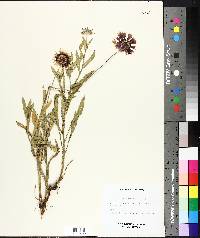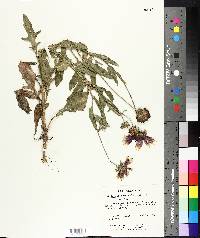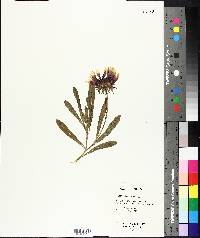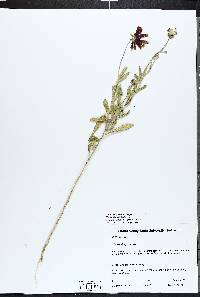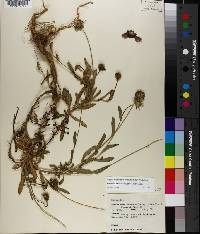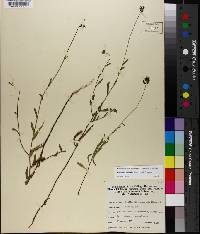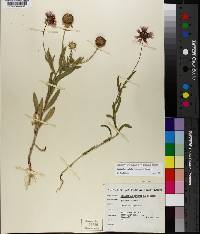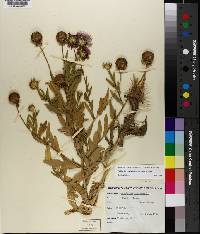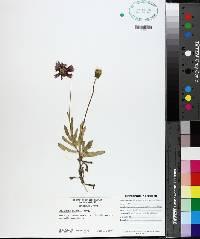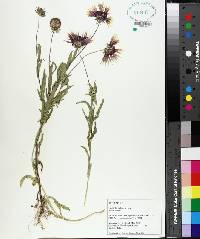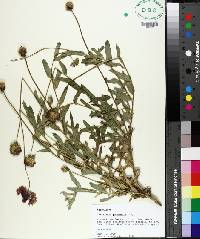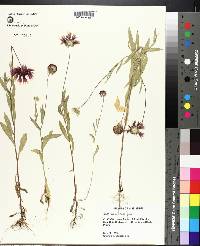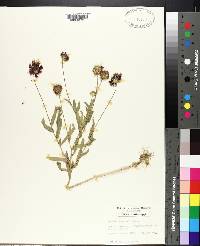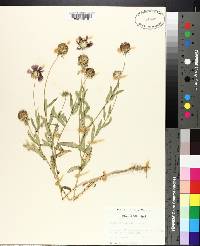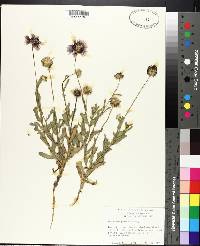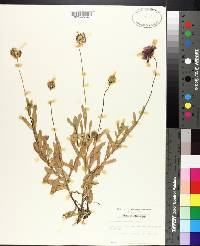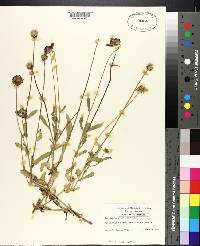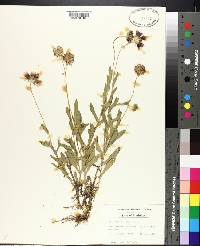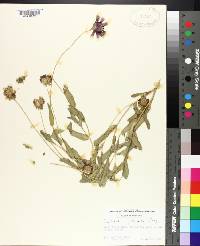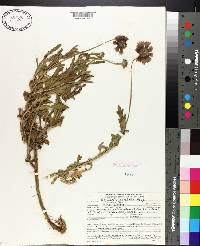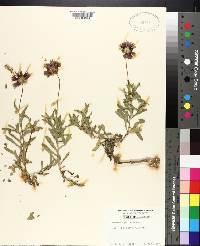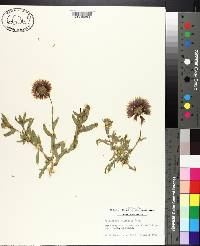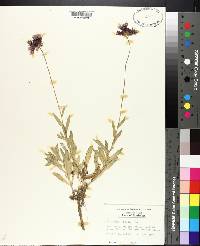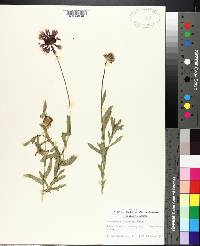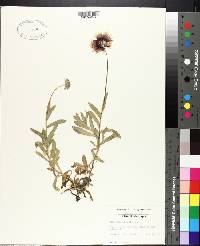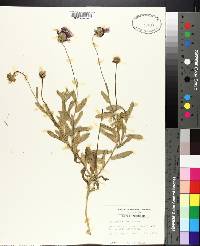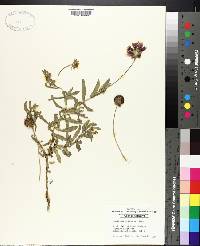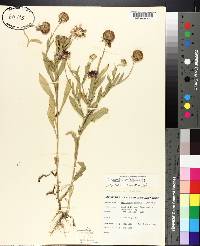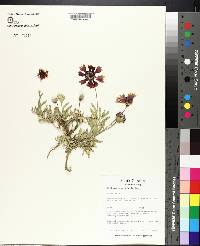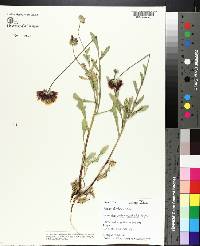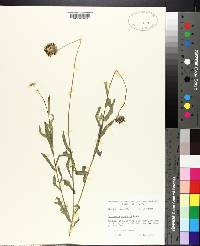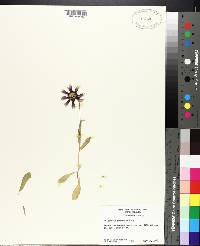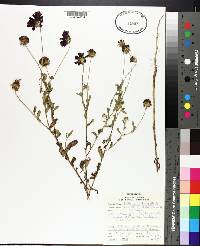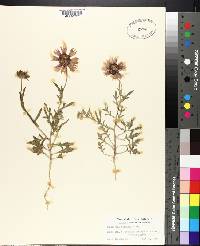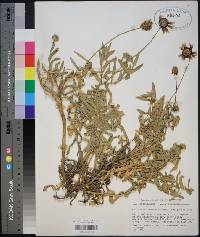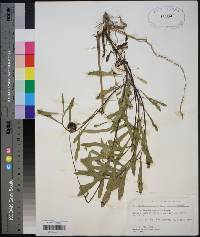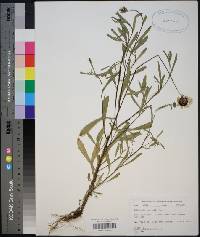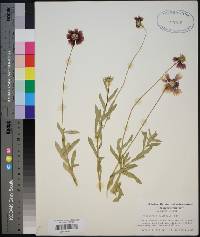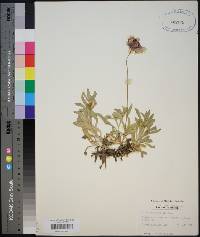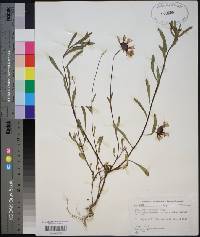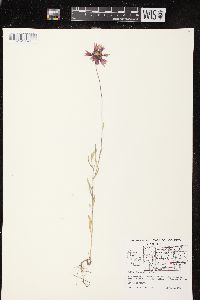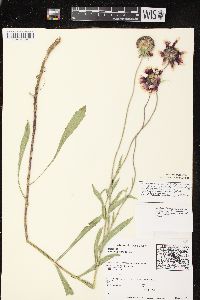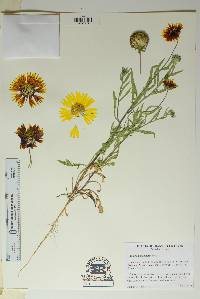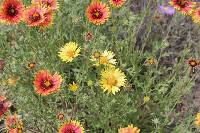
|
|
|
|
Family: Asteraceae
Firewheel, more...Indian blanket, Indianblanket, rosering gaillardia
[Gaillardia bicolor var. drummondii Hook., moreGaillardia lobata Buckley, Gaillardia scabrosa Buckley] |
Annuals (sometimes persisting), 5-35(-60+) cm. Leaves cauline; petiolar bases 0-3+ cm; blades linear, oblong, or spatulate, 1-5(-12) cm × 4-12(-35) mm, (bases of distal ± clasping) margins usually entire, sometimes toothed or lobed, faces closely strigillose or hirtellous to ± villous (hairs jointed). Peduncles 3-10(-20) cm. Phyllaries 18-28+, narrowly triangular- to linear-attenuate, 6-14+ mm, usually ciliate with jointed hairs. Receptacular setae 1.5-3 mm. Ray florets usually 8-14, rarely 0; corollas usually reddish to purplish proximally, yellow to orange distally, rarely yellow, reddish, or purplish throughout, 13-30+ mm. Disc florets 40-100+; corollas yellowish to purple or brown, often bicolored, tubes 0.8-1.2 mm, throats campanulate to urceolate, 3-4 mm, lobes deltate to ovate, often attenuate, 1-3+ mm, jointed hairs 0.3+ mm. Cypselae obpyramidal, 2-2.5 mm, hairs 1.5-2 mm, inserted at bases and on angles; pappi of 7-8 deltate to lanceolate, aristate scales 4-7 mm (scarious bases 1-2.5 × 0.7-1.3 mm). 2n = 34. Flowering Jan-Dec, mostly May-Aug. Sandy or calcareous soils, often disturbed places, mostly in grasslands or open places; 0-1800 m; Ala., Ariz., Colo., Conn., Fla., Ga., Kans., Maine, Miss., Mo., Nebr., N.H., N.Mex., N.C., Okla., S.C., S.Dak., Tex., Vt.; Mexico (Chihuahua, Coahuila, Nuevo León, Sonora, and Tamaulipas). Spring-flowering plants with most of their proximal leaves pinnately lobed or coarsely toothed, mainly found in south-central Texas, have been treated as var. australis (B. L. Turner and M. Whalen 1975). Plants from near or on beaches of the Atlantic and the Gulf of Mexico, usually with somewhat fleshy leaves and often persisting for more than one year, have been distinguished as var. picta. Cultivars of Gaillardia pulchella (or of hybrids between G. pulchella and G. aristata) are used horticulturally.
FNA 2006, Martin and Hutchins 1980; Kearny and Peebles 2006, McDougall 1973 Duration: Annual Nativity: Native Lifeform: Subshrub General: Annual herbs, sometimes persisting longer than 1 year; stems appressed-pubescent, 5-35 cm tall. Leaves: Alternate and dispersed all along the stem; upper leaves clasping the stem and lower leaves petiolate; blades linear to oblong or spatulate, 1-5 cm long by 4-12 mm wide; margins entire, toothed, lobed, or sinuate-pinnatifid; faces sparsely pubescent. Flowers: Flower heads large, showy and radiate, solitary on peduncles 3-10 cm long; involucre (ring of bracts wrapped around flower head) hemispheric, 1-2 cm wide, the bracts (phyllaries) 18-28 in 2-3 series, narrowly triangular to linear-attenuate, usually ciliate with jointed hairs; ray florets 8-14, the laminae (ray petals) 15-30 mm long, 3-lobed, reddish to purplish near base and yellow to orange near tips; disc florets 40-100, the corollas 0.5 to 1 cm high, yellowish to purple or brown, often bicolored. Fruits: Achenes obpyramidal, 2 mm long, with 2 mm long hairs inserted at achene bases and angles; topped with a pappus of 7-8 aristate scales 4-7 mm long. Ecology: Found in open sites and in disturbed areas, from 4,000-6,000 ft (1219-1829 m); flowers year-round but mostly May-August. Distribution: Native to much of N. America and Alaska except the NW US and w CAN; south to S. America; also in Eurasia, Africa and AUS. Notes: Distinguished by its showy, three-lobed, bicolored ray flowers with red inside and yellow outside (yellow only in G. pinnatifida); the showy deep red disc flowers; the leaves which are usually entire and with clasping bases; and the fact that it is usually an annual. The keys distinguish G. pulchella from other Gaillardia spp. by the long-acuminate teeth on the lobes of the disc corollas. Ethnobotany: Used as an ornament in homes, as a good luck charm, rubbed on breasts to wean infants, and as a psychological aid for drummers. Etymology: Gaillardia is named for Gaillard de Charentonneau, an 18th century French patron of botany; pulchella is derived from the Latin for beautiful. Synonyms: None Editor: SBuckley 2010, FSCoburn 2015, AHazelton 2016 Glandular-villous annual or sometimes short-lived perennial, 1-6 dm, simple to more often freely branched and with several or many heads, often decumbent at base, the littoral forms commonly somewhat succulent; disk 1-2.5 cm wide; rays purple or the tip yellow, mostly 1-2 cm; setae of the receptacle about equaling or only slightly exceeding the achenes; otherwise much like no. 1 [Gaillardia aristata Pursh]; 2n=34, 68. Dry, often sandy places, sometimes on sea-beaches; Mo. and s. Neb. to Colo., N.M., and n. Mex., and along the coast from Tex. to Fla. and se. Va. May-Sept. (G. drummondii; G. picta Sweet, the littoral phase, perhaps properly to be treated as a distinct var.) Gleason, Henry A. & Cronquist, Arthur J. 1991. Manual of vascular plants of northeastern United States and adjacent Canada. lxxv + 910 pp. ©The New York Botanical Garden. All rights reserved. Used by permission. From Flora of Indiana (1940) by Charles C. Deam Indiana Coefficient of Conservatism: C = null, non-native Wetland Indicator Status: FACU |
|
|
|
This project was made possible in part by the Institute of Museum and Library Services [MG-70-19-0057-19].
Powered by Symbiota

